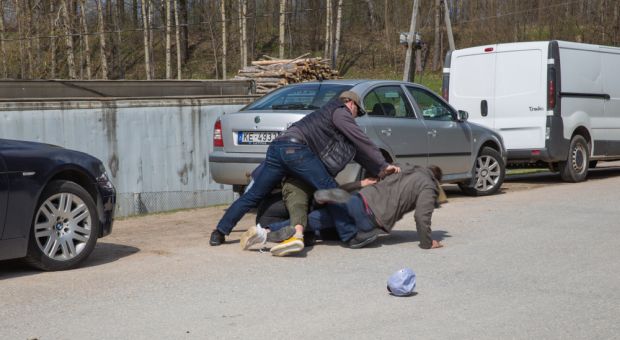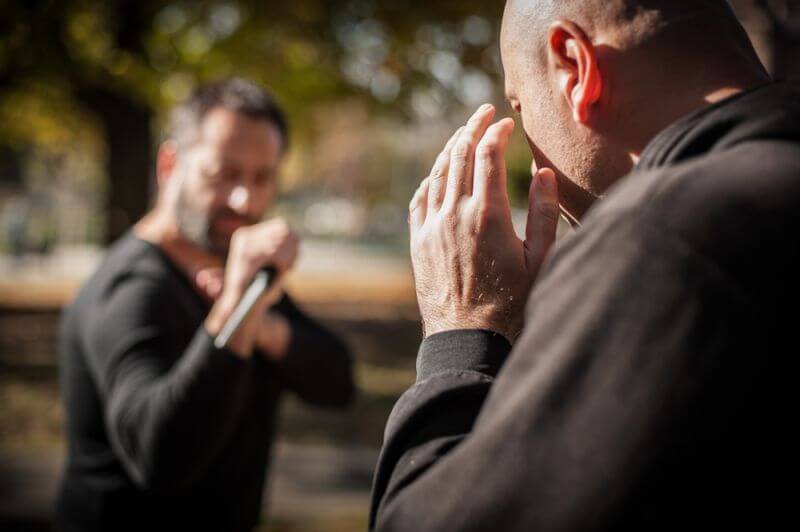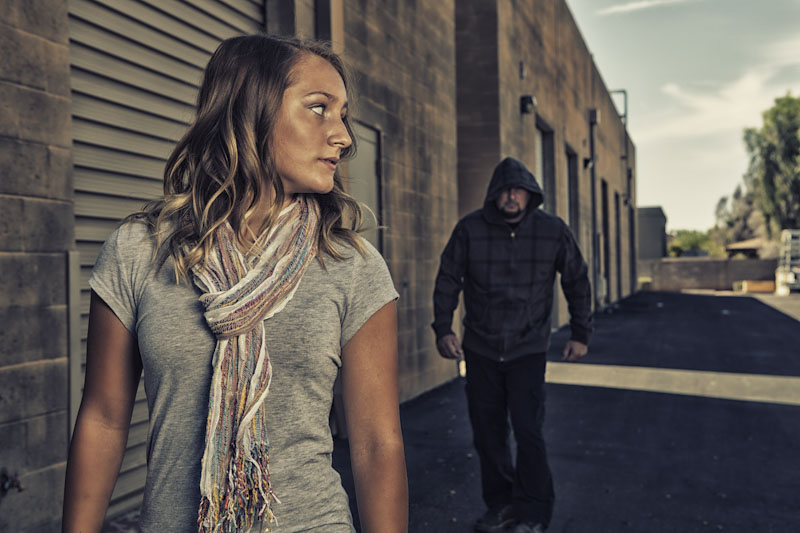The survival needs we encounter on a day-to-day basis are considerably different than the TEOTWAWKI events we tend to prepare for.
While those major disasters are always a possibility, we are all statistically much more likely to have to deal with problem like natural disasters, violence and personal disasters in our lives.
Violence can come in many forms and there is a lot of information about dealing with it online. Whole organizations exist to train preppers, survivalists and ordinary citizens in how to react to a violent situations. Some study martial arts or other means of self-defense to counter this risk, while others of us carry concealed. But it is rare to find anyone who is looking at the potential of violence in its entirety, with the focus on surviving those events.
How To Build a Small Bunker in Your Backyard with $400
As long as humankind has existed, there has been violence. Ever since the first caveman threw a rock at his neighbor and the neighbor grabbed a stick to defend himself with, violence has been a part of the human condition. But the motivation behind those attacks can be very different, with good people limiting their use of violence to protecting themselves and others from the bad people, who use violence for their own selfish ends.
Of course, this isn’t limited to just individuals. Throughout history there have been groups of people, organizations and even nations who have chosen to be the aggressor, using violence to further their own causes. A surprisingly high number of these people have claimed that they were merely using violence to counter violent people; but invariably they are calling actions of others “violent” when they are not.
Such is the case today, with some groups claiming that “hate speech” is violent, therefore justifying a violent response. But the same people are the ones who get to define what hate speech is; invariably defining it as anything that doesn’t agree with their own ideas. So much for fairness and justice.
This isn’t the only violence that exists though; there is always criminal violence, something that goes back to those two cavemen we were talking about. Criminals have always used violence or the threat of violence to get their victims to do as they want. It is, in a sense, their stock in trade, which they use to overpower those who aren’t willing to use violence.
The Most Important Strategy
I’ve carried a gun for years. As such, I’ve written a lot on the use of guns and other weapons for self-defense. I shoot regularly, working to maintain the ability to regularly shoot a one inch group. I also practice with other weapons, desiring to maintain at least some measure of competence with them as well. Guns aren’t the ideal weapon of choice in all situations.
But just because I carry a gun all the time and practice using it, that doesn’t mean that I’m walking around looking for an excuse to kill someone or even to show that I’m carrying it. I have managed to live this long without having to shoot anyone, and I’m hoping to live the rest of my life the same. Fortunately, the few times I’ve needed to draw my pistol, I haven’t had to go so far as to fire.
That’s actually not all that surprising, as in 70% of the cases where a handgun is used in self-defense, all the individual has to do is show that they are armed and able to defend themselves. That’s enough to cause the criminals to turn and flee. By and large, they don’t want to get into an armed confrontation.
This is a useful attitude and one which I hope everyone who carries a gun has as well. While I hope I would never shirt away from using my gun to defend home and family, I would rather defend them without having to resort to a shootout. It’s not that I’m afraid of a shootout; it’s that I don’t want to have the results of that shootout on my conscience for the rest of my life.
Yes, there are psychological repercussions to shooting a fellow human being. At least, there are for those of us who are psychologically and morally sound. Those who don’t have the mental mechanisms to cause those repercussions are largely considered to have something wrong with them. We obviously don’t want to be part of that group.
So, the question is, how do we avoid getting involved in a shootout, without allowing ourselves to become victims? The key is avoiding the shootout altogether. Granted, there are times when you can’t do that; but if you can, it just makes sense to do so.
We need to remember that it’s not our jobs to be heroes. Rather, it’s our jobs to protect ourselves and our families. With that in mind, we really aren’t required to run to the sounds of the guns, no matter how much we might be tempted to do so. Rather, there might be times when self-defense or protection of our families actually requires us to run from the sounds of the gun, even though that might seem like the coward’s way out.
But avoiding a fight that’s not really yours isn’t a coward’s action; it’s called prudence. Fights are dangerous and there is no guarantee that you’ll come out of the fight alive. If you die, defending someone other than your family, who is going to be there to defend your loved ones? Isn’t that really your job?
Keep Your Eyes Open
The first step here in effectively avoiding a fight is to keep your eyes open. Many criminals telegraph their intentions by their words or actions. If you recognize them for what they are; you can get out of there before things turn serious.
Situational awareness is something we are all supposed to be practicing anyway. So, all I’m talking about is how we react to that situational awareness. Instead of turning to a “fight” mode, we might be better served by turning to a “flight” mode, even if that doesn’t seem like the “manly thing to do.”
Use Whatever Intelligence Sources You Have
Many dangerous situations, which are likely to turn violent, become broadcasts over social media and local news, before they become dangerous. Yet many choose to ignore these intelligence sources; relying on their own reconnaissance instead. While personal reconnaissance is good, there is nothing wrong with hearing from other sources.
Heading into a known dangerous situation is foolish; especially if it can be avoided. Yes, there are times when it can’t be avoided; but there are others where it can. It only makes sense to keep our collective ears to the ground, so as to ensure that we know what is happening and what dangers exist.
We all know that some parts of town are dangerous; but do we know which ones they are? Do we know what areas protesters who are likely to turn violent are likely to be meeting in? Do we know what protests might be scheduled in our area? All of this is important intelligence to have at our fingertips, at all times, so that we can plan our shopping trips and other forays to avoid those areas.
Know when to Leave
This is the key; knowing when it’s time to leave. That isn’t after you take a shot; it’s before things start. It requires recognizing the signs that something is about to go down and then making a decision to be elsewhere when it happens. That, in turn, means being willing to set aside your desire to be the hero, so as to meet your greater responsibility of protecting your family.
Granted, if you make the decision to leave, there’s always a chance that you’ll be wrong. You might make that decision sometime when you don’t really need to go. Actually, you’ll probably make that mistake a lot of times. But that’s okay; if things don’t go bad, you can always go back.
Diffusing the Situation
There are also times when things are turning violent, where you can stop them, without it becoming a fight. People today take offense at the slightest things, responding to that provocation with violence. Even so, there are times when you can stop the violence, simply by giving a soft answer to their anger.
Probably one of the worst places for this is a bar. Bad tempers and alcohol don’t mix. Some people tend to be angry drunks, who are quick to take offense and react violently to it. But that doesn’t mean that you have to play their game. You can change the game, making it clear that any aggression will be caused by their desire for that violence, not in response to something you did wrong.
Take, for example, a situation where someone says, “What are you looking at?” This is a fairly common question that might be asked, when someone thinks that you are staring at them or someone with them. Few of the common answers to this question can calm that person down; but saying something like, “I’m looking at your shirt. Where did you get it?” will.
Why does that sort of response work? Because it take the game outside of their expectations. In doing so, it prevents them from answering with their preplanned response. So, instead of reacting with violence or aggression, they have to think about their answer. That’s enough to stop them in their tracks.
When it’s Time to Fight
No matter how hard you try to avoid a fight there are always some situations which are beyond avoidance or your control. If someone walks into a store to rob it, when you are there, you’re stuck. You couldn’t anticipate the situation and you can’t diffuse it. That’s why it is good to be armed.
If I haven’t already made it clear, you want to do everything you can, before drawing your gun. As long as your gun is hidden under your clothes, you still have the element of surprise. So use that to your advantage. Do everything you can to prepare for the upcoming conflict, before letting them get even an inkling that you are a danger to them. This especially includes moving into a position where you have a good tactical advantage, such as flanking them.
The basic rule is don’t draw unless you intend to shoot and don’t shoot unless you intend to kill. I stand by that rule; but with one caveat. That is, I’ll always give the bad guy the opportunity to give up the fight and flee. That’s one of the reasons for maneuvering to a position where you have them flanked. When you finally draw, you not only have the element of surprise to give you a couple of seconds of advantage, but also the time it will take them to turn. That gives you the safety of waiting to see how they are going to react.
If they choose to flee, so much the better. You don’t have to fire and live with the mental repercussions of taking a life. But if they don’t, you can at least know that you gave them every chance you could. Your action will truly be in self-defense, not only before the law, but in your own mind as well.
Finally, go back to that basic rule; you’ve already drawn with the intent to shoot, so when you shoot, do it with the intent to kill. That’s the only safe course of action you can take. If things get to that point, you have to assume that they are going to be shooting as well. Therefore, you have to stop them before they can kill you or someone else. That means putting them on the ground, without a weapon in their hand. That’s the only safe conclusion to a situation in which you find that you are forced to draw your concealed firearm, with the intent of protecting your life and the lives of others.










Shamrock | February 26, 2019
|
“Those who don’t have the mental mechanisms to cause those repercussions are largely considered to have something wrong with them.”
I take exception to that statement.
Obviously, the writer has not been in the military. That’s a snowflake’s outlook..
The writer states he has had to pull his gun but not use it.. That is the best outcome.. No one wants to be responsible for the loss of life. But when you are a victim and someone else is the aggressor, its very different.
Repercussions . . . .. You don’t need to have any “coping mechanisms” or anything “wrong with you” to believe in “an eye for an eye, a tooth for a tooth.” If someone has pulled a gun on you, its gonna be either you or them! Simple! Make your choice, act on it, move on and live with it. Folks have lost the ability to say “Tough shit – You got what you deserved.”
We really will not know until it happens, . . . . but remorse is not in my make-up.
Joan | February 26, 2019
|
What do you mean by “flanking” them?
Cilla Wilson | March 1, 2019
|
That generally means to the back/side.
Michael Pastien | March 7, 2019
|
Being visibly positioned sideways, out of the armed assailant’s direct line of fire…with your firearm pointed at them, obviously ready to shoot if they make a wrong move.
Bill in Idaho | February 26, 2019
|
Bill, Your Core base Rule – ” . . . don’t draw unless you intend to shoot, and don’t shoot unless you intend to kill . . . ” is Right on the Money. I allow One variation to this : If I am well positioned (Behind Good Cover), and if I am in an “Open” shooting position – assured of steady accuracy; Then I will take the shot. My two bullets will travel directly into the Center of the criminal’s “Brachael Plexus”. (This Nerve complex is located halfway between the armpit and the base of the neck.) I always plan and practice this type of shooting in “Double Tap” Mode. This action assumes that I can positively observe which hand (Right or Left) the shooter is using – his trigger hand / “Strong Side”; therefore, that is the side I will target. The result is that the offending shooter will Live, but he will spend the remainder of his life as a “One-Armed” man. His strong side arm will No Longer function – from shoulder to finger-tips – Ever Again. That is the morally correct action.
TheObtuse | February 27, 2019
|
“It is the hard heart that kills. If you do not have hard heart, you will pause at the moment of truth, You will be dead marines, and you you will be in a world of….”. Truer words have never been spoken. You must have pre visualized that moment where you will be required to take that life indefence of your own or others. That does not make you like your attacker, who inside themselves have decided that your life is worthless compared to their desires.
Oren | March 1, 2019
|
Bill White’s advice is tried and true. My grandfather was born in 1884, obviously long since passed on. I used to sit on his ottoman and listen as he told of his life. It was fascinating. One thing he said once, and only once, stuck with me. “If you ever point a gun at someone, you have to kill him.” I have remembered that for a long time. I’m 72 now. But the advice is more relevant today than then with the hair trigger tempers running loose today.
Oral (O. K.) Neal | March 19, 2019
|
Bill in Idaho, You talk as if you have never been in a combat situation, or in a deadly gunfight. I have been in both and can testify that when you are full of adrenalin with your heart pumping so hard that your sight pattern keeps jumping and your reptilian brain took over before you reached for your weapon, you won’t be able to put two rounds in the same hole. Police officers are taught to “double tap” because one of them might miss.
Also, “everyone” knows you “shoot to kill.” Anybody with any experience laughs when The Lone Ranger shoots guns out of the bad guy’s hand. You shoot “center mass” or you die. And remember, if you make him a one-armed man, you will still be facing a civil trial. I can hear the family’s lawyers ask, “You told everybody on the internet what a good shot you are. Why did you kill the deceased instead of “winging” him?”
Not trying to offend, simply put other ideas out there to think about.
OK Neal
SDC Instructor
Level Five
NRA Instructor
CCH Instructor